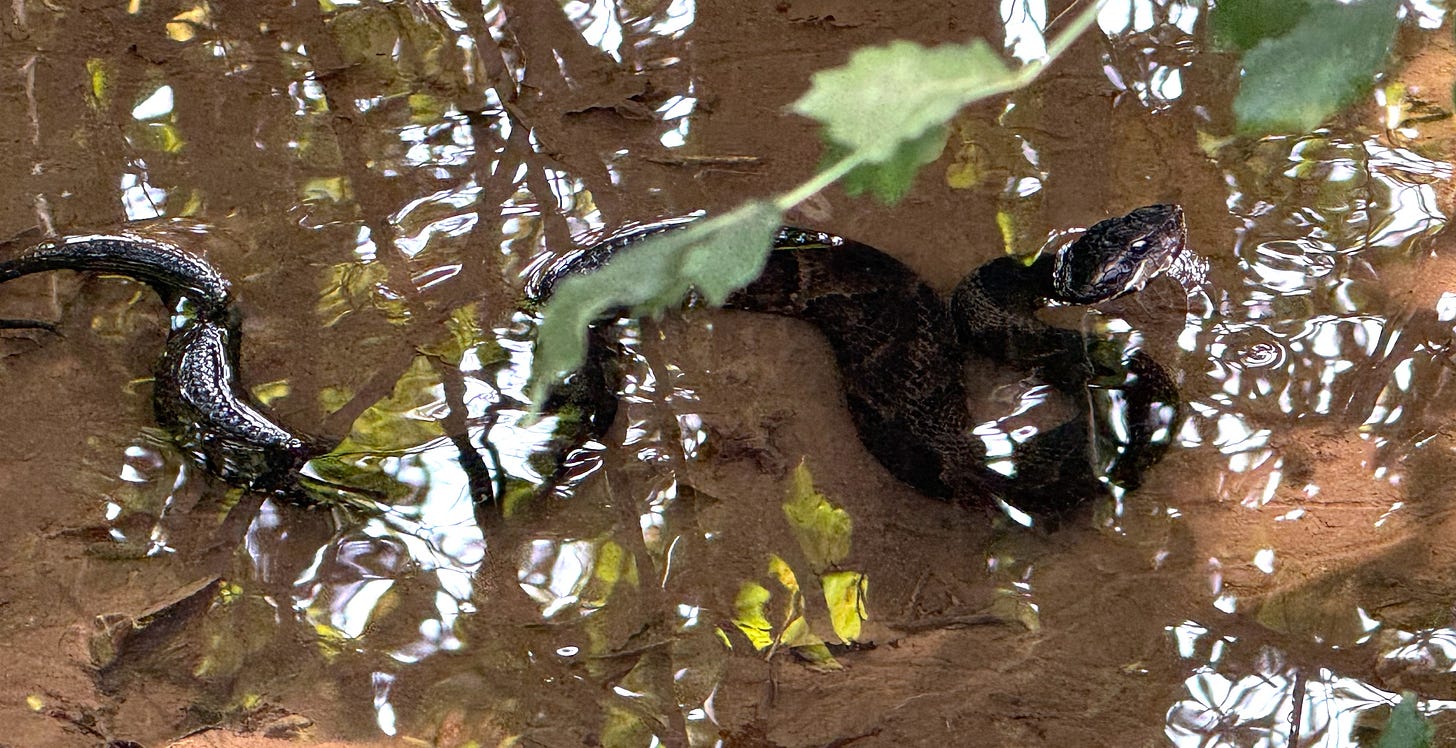I was walking along the spring branch that feeds Piney Creek when I heard a sudden splash and saw the water stir. A northern cottonmouth had slipped from the bank and was gliding into the shallow water.
Fear was the first thing that I felt. A jolt of adrenaline rushing through my body before my mind could even name what I was seeing.
I felt my chest tighten, and the old stories of danger rushing into my mind. So I slowed my breath into a steady rhythm and let each exhale run a little longer than the inhale.
Breathing in, I counted one, two, three, four. Breathing out, I counted one, two, three, four, five, six. After a couple of rounds I felt my pulse ease, and my shoulders drop.
The cottonmouth had only moved a few feet away. It wasn’t striking or charging. It was simply watching me as I was watching it. Both of us alert and holding our ground, but neither of us looking for trouble.
It reminded me how much of our fear of the wild comes from stories we inherit. A snake is cast as a villain, or a coyote as a menace. But standing there by the water, I saw how much those stories miss. What looks like danger is often only another creature wanting space.
Snakes and the Stories We Tell
Cottonmouths (also called water moccasins) have one of the fiercest reputations of any North American snake. Ask most people and they’ll tell you cottonmouths are aggressive, quick to strike, and likely to chase you. But scientific studies tell another story. In controlled research, fewer than 20 percent attempted to bite even when stepped on, and most simply tried to get out of the way.
This doesn’t mean we should be careless. A venomous snake deserves respect. If cornered or harassed, it will defend itself, but the truth is that snakes would rather conserve their energy than waste venom on something they cannot eat. Most bites happen when someone provokes or handles them.
These days I try to meet them with awareness and a little distance, instead of a hoe or a shovel. This has allowed me to see the snake as my neighbor in the ecosystem. They help control rodents, while helping me remember to step carefully and stay present.
Coyotes at the Edge
The same pattern holds with coyotes. In the news, their image swings between trickster and threat. We hear stories of pets snatched, children nipped, or late-night howls that sound too close for comfort.
There have been a incidents with coyotes and human, no doubt. They have mostly involved small children and they are often in neighborhoods where coyotes have lost their fear of humans because of food left out or intentional feeding.
In over forty years of records across the U.S. and Canada, there have been hundreds of documented encounters, but only two confirmed fatalities: a toddler in California in 1981 and a 19-year-old hiker in Nova Scotia in 2009.
For adults, the odds of a serious coyote attack are almost nonexistent.
Closer to home, I see coyotes adjusting as more habitat disappears to housing developments. Now and then I’ll catch one in the daylight, standing tall on a hay bale before loping off the moment it notices me. Many nights I step outside and hear a pack kicking up together, yelping and calling through the dark.
Some hear a menace in those voices, but to me they sound like celebration. A gathering of kin announcing their presence, and holding community in a world that is steadily closing in.
Fear and Rewilding
George Monbiot in Feral writes about the way our fear of predators has hollowed out our relationship with the wild. Wolves, he points out, have killed no one in modern U.S. history, yet they carry the weight of centuries of fairy tales and nightmares. Coyotes have become the inheritors of that fear.
But most of what we imagine is myth.
What is real is how fear narrows our life. It makes us see enemies instead of neighbors.
It convinces us that our safety lies in domination rather than in understanding.
Rewilding, at its heart, is not only about restoring landscapes. It is about restoring relationship. At its heart it asks us to replace fear with curiosity.
Practicing Healthy Respect
Here are a few simple ways we can meet the wild differently:
Pause before reacting. If you see a snake or hear coyotes howling, notice your first impulse. Is it fear? Anger? Curiosity? Let yourself breathe before you act.
Give space. Most wild animals want nothing more than distance. Step back, make noise, and let them move off.
Learn their role. Snakes control rodents. Coyotes keep rabbit and deer populations in check. Even spiders thin out insects around our homes.
Keep boundaries. Don’t feed wildlife. Secure trash. Supervise pets and children outdoors. Respect goes both ways.
Of course there is always some risk, just as there is in driving a car down the road. Perspective matters. We often fear the creatures least likely to harm us while ignoring the daily dangers we take for granted.
Coming Home to the Wild
That cottonmouth by the creek could have been a story of fear.
Instead it became a moment of communion.
To walk with awareness is to know that I am not the only one who belongs. The world is alive with neighbors who ask for nothing more than space, respect, and acknowledgment.
All around us, life is speaking if we are willing to listen. It reminds us that it’s less about restoring land and more about remembering our place in the community of life.
If you’d like to see the cottonmouth I mentioned, here’s a short video from that encounter:

